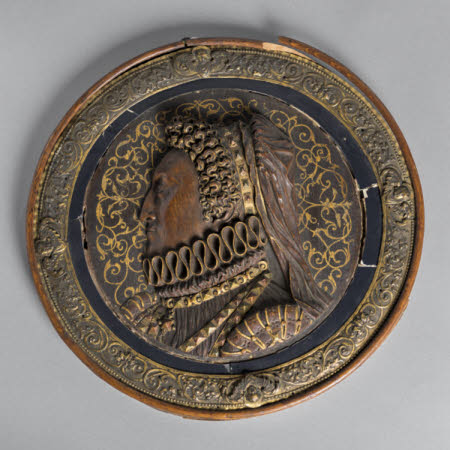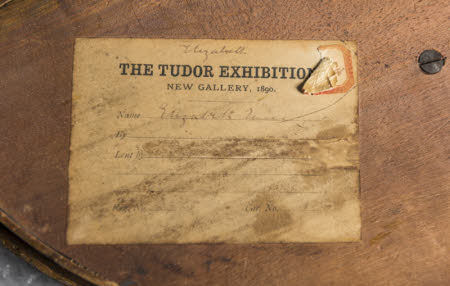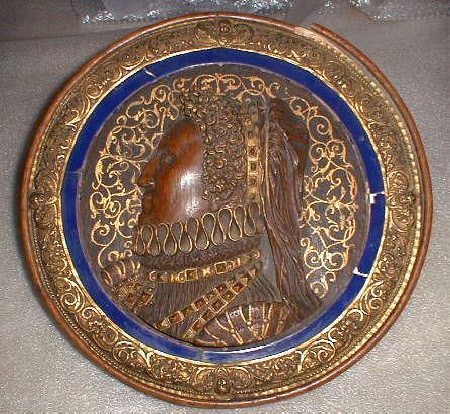Elizabeth I
Category
Art / Sculpture
Date
circa 1850 - circa 1899
Materials
Painted and gilt oak, ceramic
Measurements
400 mm (Diameter)
Place of origin
Great Britain
Order this imageCollection
Belton House, Lincolnshire
NT 436756
Summary
Painted oak, walnut and ceramic, Elizabeth I (1533-1603), British, probably 19th century. A portrait relief medallion of Elizabeth I in profile carved in oak, gilt and painted. The queen is shown in her middle to late age, facing left. The hair is dressed with a band (jewels painted red and green) and veil. She wears a ruff and dress with puffed, slashed sleeves and a jeweled girdle (painted red and green). The ground is painted with a scrolling floral motif. The medallion is mounted in a blue glazed ceramic frame, a gilt repoussé metal frame with a floral arabesque pattern and four winged putti, a fine oak frame and walnut backing. The ceramic and oak frames are broken in a number of places. Affixed to the back of the medallion is an exhibition sticker from ‘The Tudor Exhibition’, at ‘New Gallery, 1890’ and a sticker with a blue frame inscribed ‘Ashridge’.
Full description
The oak medallion is inspired by miniature, cameo, pendant and coin portraits of Elizabeth I. See, for example, an oval cameo in the Victoria and Albert Museum, London, where the queen wears a similar veiled headdress, close-fitting ruff and jewelled girdle (museum number 1603-1855). In this cameo and in others (e.g. British Museum, London, 1914,0926.1) she is also facing left and has the same aquiline nose. The queen is similarly depicted in two pendant portraits set lavishly in gold: the Heneage Jewel in the Victoria and Albert Museum, London (M.81-1935) and the Phoenix Jewel in British Museum, London (SLMisc.1778). The blue glazed ceramic frame may also refer to the distinctive blue background used in portrait miniatures by Nicholas Hilliard (1547-1619): see, for example, Hilliard’s miniature of Elizabeth I, 1572 (National Portrait Gallery, London, NPG 108). The oak medallion was lent by the 3rd Earl Brownlow (1844-1921) for a major ‘Exhibition of the Royal House of Tudor’ at the New Gallery, London, 1890. It was displayed within the category of ‘Relics, Vestments &c.’ in the North Gallery, which covered the reign of Elizabeth I (1533-1603). The exhibition catalogue describes the roundel thus: ‘1024, Queen Elizabeth, Medallion, carved in oak, formerly belonged to Lord Chancellor Egerton.’ Thomas Egerton, 1st Viscount Brackley, PC (1540 -1617) served as Lord Keeper for Elizabeth I and later as Lord Chancellor under James I. The medallion is claimed to originate from Ashridge House, a royal residence Egerton purchased on Elizabeth I’s death in 1603. Centuries later, in 1848, Ashridge was inherited by the Earls Brownlow. No similar objects appear to have been made in the Elizabethan and early Jacobean era leading this cataloguer to propose that the medallion may be a 19th century Tudor revivalist object. Lord Brownlow was Vice President of the New Gallery in 1890. The catalogue shows that he lent a further eleven objects for exhibition: 22: portrait of 'Henry VII (1485-1509)' by Jan de Mabuse 83: portrait of 'Mary Tudor, Dowager Queen of France, Afterwards Duchess of Suffolk (1497-1534)’ by Hans Holbein 114: portrait of ‘Charles Brandon, Duke of Suffolk, K.G. (d.1545)’ by Hans Holbein 205: portrait of ‘Philip II of Spain (1556-1598)’ by Titian 299: portrait of ‘Sir Thomas Egerton, Baron Ellesmere, Viscount Brackly, Lord Chancellor (1540?-1617)' 797: ‘Stool, covered with tapestry, worked by Queen Elizabeth when residing at Ashridge’ 806: ‘Marble bust of Edward VI’ 807: ‘Marble bust of Cardinal Wolsey’s Black Page-Boy’ 1027: ‘Silver-gilt Oar, formerly borne before the Mayor and Corporation of Boston to denote the Admiralty jurisdiction granted to the town by Queen Elizabeth.’ 1054: ‘Baby linen, made by the Princess Elizabeth for her sister Mary, when the Queen believed herself to be with child.’ 1152: ‘Panel, with figure of Elizabeth in a garden with suite…The panel was found a short time ago in the old manor house at Little Gaddesden, close to Ashridge. It is only a portion of the painting, the rest of which remains on the wall, this part forming the door to a cupboard in the wall. The house is supposed to have been occupied by the steward of the royal household at Ashridge’ Alice Rylance-Watson October 2018
Provenance
Ashridge Collection (1890);[...]; purchased with a grant from the National Heritage Memorial Fund (NHMF) from Edward John Peregrine Cust, 7th Baron Brownlow, C. St J. (b.1936) in 1984.
Credit line
Belton House, The Brownlow Collection (acquired with the help of the National Heritage Memorial Fund by the National Trust in 1984)
Marks and inscriptions
Back, bottom left: Exhibition label affixed, printed 'THE TUDOR EXHIBITON | NEW GALLERY, 1890' with catalogue record: Name (printed) inscribed in pen and black ink 'Elizabeth Queen' By (printed) blank Lent by illegible, smudged Reg. No. illegible Cat. No. blank Inscribed in pen and black ink at top of label 'Elizabeth' Back, bottom: Small label with blue frame, inscribed in pen and black ink 'Ashridge'
References
Exhibition of the Royal House of Tudor 1890., p.201, no.1024


